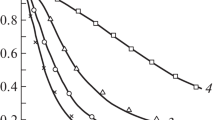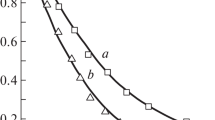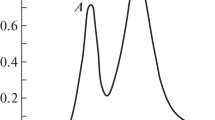A considerable number of investigations have been carried out to date on the optical orientation of electrons in semiconductors [1–6]. In most cases, the effectiveness of the orientation was determined principally by the spin relaxation of the electrons at the bottom of the conduction band. We show in the present paper that the degree of stationary orientation of the non-equilibrium electrons can be determined to a considerable degree (depending on the impurity concentration) by the spin relaxation occurring upon thermalization of the “hot” electrons produced by the light.
Similar content being viewed by others
Avoid common mistakes on your manuscript.
We investigated the dependence of the degree of orientation of the electrons (P) on the quantum energy of the exciting light (hν) in p-GaAs crystals with impurity (Zn) concentration 7.8 × 1016–4 × 1019 cm–3 at temperatures 4.2 and 77 K. Figure 1 shows the obtained P(hν) plots for two values of the impurity concentration. The degree of orientation P was measured, as before [3–5], by determining the degree of circular polarization of the recombination radiation. We see that the form of the P(hν) curves depends on the impurity content, and for crystals with low impurity concentration there is observed even an inversion of the sign of P, i.e., a reversal of the direction of the predominant orientation of the spins.
Theoretically such a possibility was predicted by D’yakonov and Perel’ [7] and it was shown that such an effect is due to the spin–orbit splitting of the valence band in GaAs and the spin relaxation of the “hot” electrons. According to the selection rules for the interband transitions, the degree of orientation of the electrons falling in the conduction band from the upper valence subbands (light and heavy holes) is P = 0.5; for transitions from the split-off band we have P = –1 [7]. Thus, as a result of transitions from different valence subbands there are produced in the conduction band electrons with opposite directions of the predominant orientation of the spin. The transitions from the split-off band become manifest only at hν > Eg + Δ, where Eg is the width of the forbidden band and Δ is the spin–orbit splitting of the valence band. As such quantum energies of the light, however, the electrons excited from the split-off band fall in a region near the bottom of the conduction band (Fig. 2) and those excited from the upper valence subbands fall deep in the conduction band (hot carriers are produced). Therefore, the relative contribution of the electrons excited from different valence subbands to the orientation of the carriers at the bottom of the conduction band (which is the quantity measured in the experiment) will be determined also by the spin relaxation occurring during thermalization of the hot electrons.
In the case of weak spin relaxation, the hot electrons retain fully their orientation during the time of thermalization at the bottom of the conduction band, and the degree of orientation is determined only by the relative contribution made to the absorption by transitions from different subbands. The corresponding theoretical P(hν) curve is shown in Fig. 1. For GaAs we have Eg = 1.52 eV and Δ = 0.33 eV, and the sharp decrease of P near hν = I.85 eV corresponds to the start of the transitions from the split-off band, which give a “negative” contribution to the orientation. The summary degree of orientation retains a positive sign since the absorption coefficient for the transitions from the upper subbands is much higher than for the transitions from the split-off band. The theoretical curve, as seen from Fig. 1, agrees with the experimental oneFootnote 1 corresponding to a strongly doped crystal. This shows that at a large impurity concentration in the crystal the relaxation of the “hot” electrons at the bottom of the band is not accompanied by relaxation of their spin. A similar result was obtained for an impurity concentration of the same order in [6].
For the crystal with the lower impurity concentration (Fig. 1, curve 3), the degree of orientation decreases to zero even before the start of the transitions from the split-off band. This means that at a given impurity concentration there is a spin-relaxation mechanism, the efficiency of which strongly increases with increasing electron energy. The form of the P(hν) curve shows that the dependence of the rate of spin relaxation on the energy of the hot electron has a threshold character, namely, the relaxation increases sharply for electrons having an energy higher than a certain critical value εcr. For curve 3 of Fig. 1 we can estimate εcr \( \simeq \) 0.28 eV, and therefore at hν > Eg + Δ the hot electrons excited in this crystal from the upper valence subbands make no contribution to the orientation of the electrons at the bottom of the conduction band, and the negative sign of P at hν > 1.85 eV is due to the contribution of the “cold” electrons excited from the split-off band, which have “negative” orientation. The decrease (in absolute magnitude) of the degree of “negative” orientation observed in the region of hν > 2.1 eV, is determined by the same threshold value of εcr, but for the hot electrons excited from the split-off band. In crystals with larger impurity concentration there was observed an increase of the threshold value εcr and the P(hν) curve had an intermediate form compared with those shown in Fig. 1.
Figure 3 shows the dependence of the degree of orientation P on the impurity concentration in p-GaAs for two fixed values of the frequency of the exciting light, 1.96 and 2.14 eV. The obtained curves reflect the dependence of the rate of spin relaxation of the hot electrons on the impurity content in the crystal. Negative and positive values of P correspond respectively to strong and weak spin relaxation of the hot electrons excited from the upper valence subbands, with fixed values of the energy –0.44 and 0.62 eV. We see that experiment yields a somewhat unusual result: an increase of the impurity concentration leads to a weakening of the spin relaxation of the hot electron.
Dependence of the degree of orientation of the electrons (P) in GaAs on the impurity concentration for two fixed values of the quantum energy of the exciting light, 1.96 (1) and 2.14 eV (2). The values of P are normalized as follows: for each impurity concentration P = 0.5 stands for the value of the degree of orientation at hν = Eg.
This result, however, agrees fully with the mechanism of spin relaxation of the hot electrons, proposed by D’yakonov and Perel’ for crystals without an inversion center [7]: the relaxation is due to the spin splitting (at points k ≠ 0) of the conduction band and increases strongly with increasing electron energy. The effectiveness of the relaxation is determined by the ratio of the spin-relaxation time to the relaxation time with respect to the energy and momentum of the “hot” electron. In doped crystals, the decrease of the relaxation time with respect to the energy and momentum of the hot electron with increasing content of the impurity should lead to a weakening of the spin relaxation, and accordingly to an increase of the threshold value of εcr for the spin relaxation due to this mechanism.
The point P = 0 on the curves of Fig. 3 corresponds approximately to an impurity concentration at which εcr ≈ hν – Eg. From the presented data for two values of the frequency of the exciting light we can estimate that, in accordance with the theory [7], the relation εcr ~ \(N_{p}^{{1/3}}\) is approximately satisfied.
REFERENCES
G. Lampel, Phys. Rev. Lett. 20, 491 (1968).
R. Parsons, Phys. Rev. Lett. 23, 1152 (1969).
A. I. Ekimov and V. I. Safarov, JETP Lett. 12, 198 (1970).
D. Z. Garbuzov, A. I. Ekimov, and V. I. Safarov, JETP Lett. 13, 24 (1971).
A. I. Ekimov and V. I. Safarov, JETP Lett. 13, 177 (1971).
B. P. Zakharchenya, V. G. Fleisher, R. D. Dzhioev, Yu. P. Veshunov, and I. B. Rusanov, JETP Lett. 13, 137 (1971).
M. I. D’yakonov and V. I. Perel’, Sov. Phys. JETP 33, 1053 (1971).
ACKNOWLEDGMENTS
We wish to thank M.I. D’yakonov and V.I. Perel’ for useful discussions.
Funding
This work was supported by ongoing institutional funding. No additional grants to carry out or direct this particular research were obtained.
Author information
Authors and Affiliations
Corresponding author
Ethics declarations
The authors of this work declare that they have no conflicts of interest.
Additional information
Publisher’s Note.
Pleiades Publishing remains neutral with regard to jurisdictional claims in published maps and institutional affiliations.
Rights and permissions
Open Access. This article is licensed under a Creative Commons Attribution 4.0 International License, which permits use, sharing, adaptation, distribution and reproduction in any medium or format, as long as you give appropriate credit to the original author(s) and the source, provide a link to the Creative Commons license, and indicate if changes were made. The images or other third party material in this article are included in the article’s Creative Commons license, unless indicated otherwise in a credit line to the material. If material is not included in the article’s Creative Commons license and your intended use is not permitted by statutory regulation or exceeds the permitted use, you will need to obtain permission directly from the copyright holder. To view a copy of this license, visit http://creativecommons.org/licenses/by/4.0/.
About this article
Cite this article
Ekimov, A.I., Safarov, V.I. Influence of Spin Relaxation of “Hot” Electrons on the Effectiveness of Optical Orientation in Semiconductors. Jetp Lett. 118 (Suppl 1), S29–S31 (2023). https://doi.org/10.1134/S0021364023130064
Received:
Revised:
Accepted:
Published:
Issue Date:
DOI: https://doi.org/10.1134/S0021364023130064







